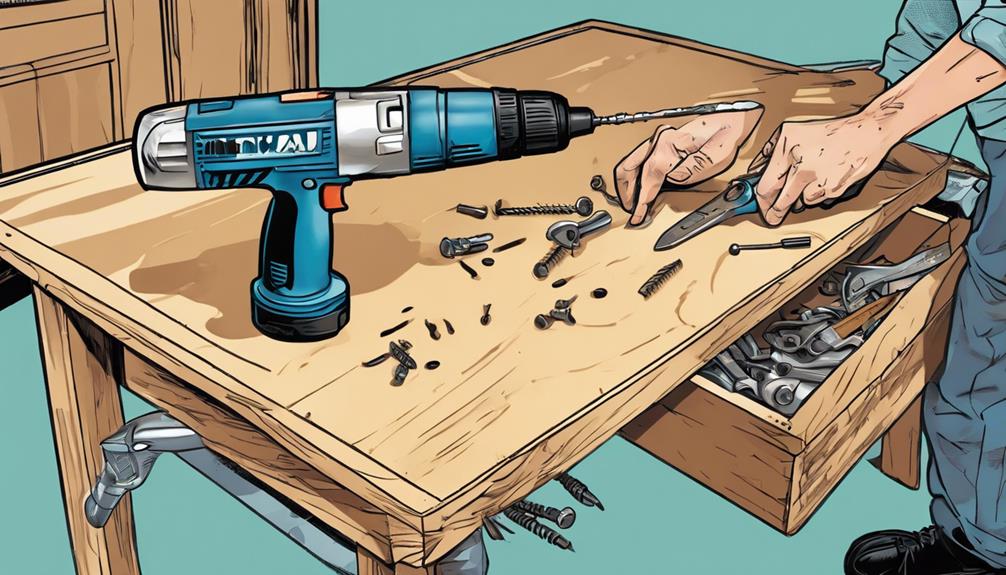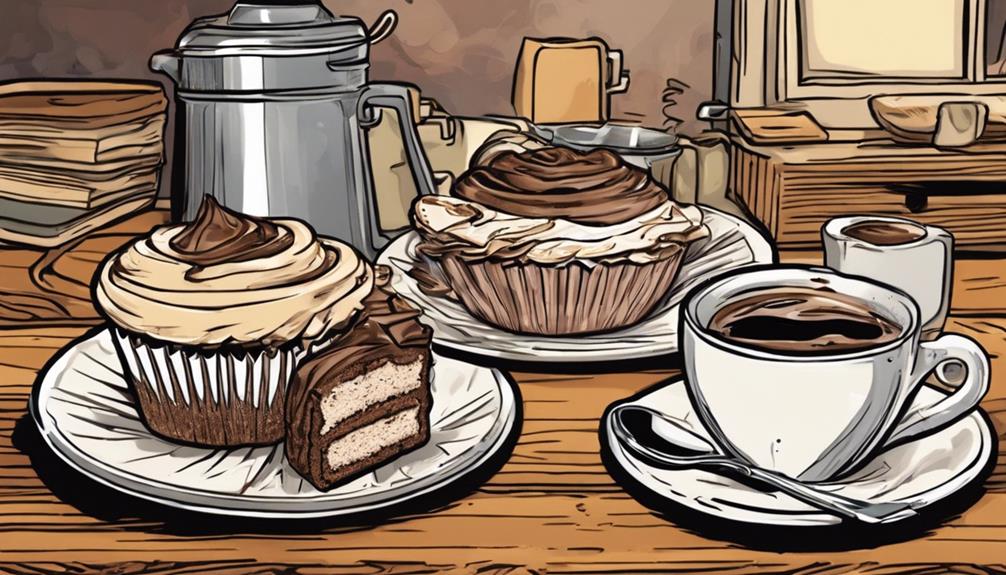Are you thinking about starting your own coffee business? Begin by developing your concept, identifying your target market, and planning your finances. Secure funding through personal savings, loans, or crowdfunding. Establish a strong foundation with a unique business plan, understanding startup expenses, and choosing a strategic location. Emphasize branding, establish a distinctive identity, and provide exceptional customer service. Create an efficient operational structure, prioritize customer satisfaction, and ensure legal compliance. Properly train and empower your staff, and recognize outstanding performance. Infuse your business with passion, differentiate yourself with quality, and attract loyal clientele. By following these steps, you are well on your way to a successful coffee business. It is also crucial to navigate through the coffee shop license application process to ensure compliance with local regulations. This includes obtaining the necessary permits and health inspections to legally operate your coffee establishment. Once everything is in order, focus on creating a welcoming environment for customers to enjoy their coffee and foster a sense of community in your shop. With perseverance and dedication, your coffee business will prosper and become a beloved fixture in your community.
Key Takeaways
- Develop a unique concept and target market.
- Secure financing and plan startup costs accurately.
- Choose a strategic location for visibility.
- Implement effective marketing strategies.
- Focus on exceptional product quality and customer experience.
Business Plan Development
When developing your business plan for a coffee shop business, make sure it outlines your concept, target market, and financial projections. A well-thought-out business plan helps set the foundation for a successful coffee shop. By showcasing the viability and potential growth of your coffee business, the business plan becomes an essential tool in securing financing.
Furthermore, the business plan should explore detailed strategies for sales, marketing, operations, and management. These strategies act as guiding principles, steering your coffee business towards success.
Identifying potential weaknesses and outlining solutions to mitigate risks are essential components of a successful coffee shop business plan.
Funding and Financial Considerations

To successfully launch your coffee business, understanding funding options and financial considerations is essential for long-term stability and growth. Here are some key points to keep in mind:
- Funding Options: When it comes to financing your coffee business, various options exist, such as personal capital, small business loans, commercial loans, or crowdfunding opportunities. Carefully assess each option to determine the most suitable choice for your specific needs and circumstances.
- Financial Planning: Utilize tools like the Restaurant Opening Calculator to guide your financial planning process. Accurate budgeting is vital to secure the long-term sustainability of your business. Consider all startup costs, including equipment, renovations, and initial inventory, which can range from $60,000 to $300,000.
- Accounting Practices: Establish accurate accounting practices from the start to manage expenses, revenues, and profitability effectively. Regularly review and adjust pricing strategies to maintain profitability and competitiveness in the dynamic coffee shop industry.
Key Steps to Launch
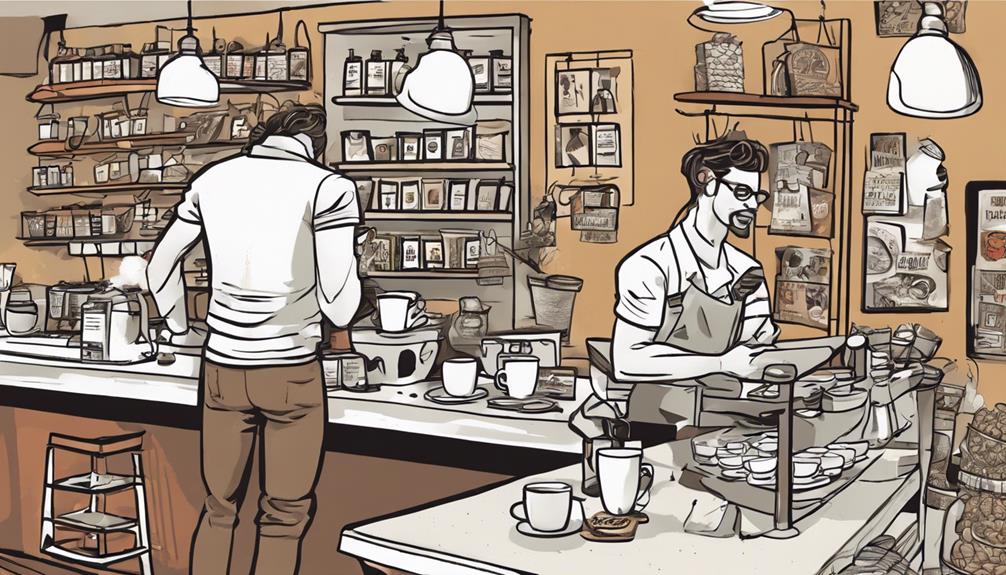
Developing a thorough business plan is an important initial step in launching your coffee business. When you start a coffee shop, creating your coffee shop's unique concept, identifying your target market, and devising a solid sales strategy are key components of your business plan.
Understanding the startup costs involved in a coffee shop startup, which can range from $60,000 to $300,000, is essential for proper budgeting and securing financing.
Another key step in launching your coffee business is choosing the right location. Factors such as demographics, foot traffic, and competition should be carefully considered as they can greatly impact your coffee shop's success.
Additionally, effective marketing strategies, including social media engagement and community involvement, play a significant role in attracting customers and building brand awareness for your coffee business.
Branding and Location Strategy
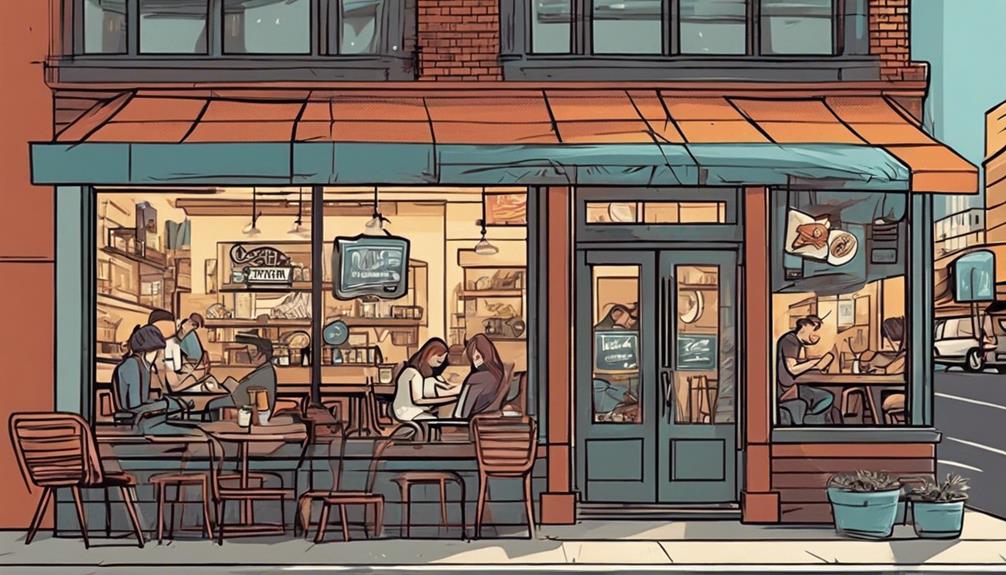
Consider how a strategic branding and location strategy can greatly impact the success of your coffee business. When establishing your coffee shop, the right branding and location decisions can make all the difference. Here's what you need to know:
- Selecting the Perfect Location:
- Choosing a strategic location is pivotal for attracting foot traffic and ensuring visibility.
- Factors such as demographics, competition, and accessibility should guide your location choice.
- A prime location can drive customer flow and boost your coffee shop's overall success.
- Building a Strong Brand Identity:
- A well-defined branding strategy sets your coffee business apart from competitors in a saturated market.
- Your brand identity should showcase your unique offerings, values, and customer experience.
- Establishing a compelling brand can help attract and retain loyal customers over time.
- Attracting and Retaining Loyal Customers:
- A strong branding and location strategy can cultivate a customer base of loyal patrons.
- Loyal customers are key to driving business growth and ensuring long-term sustainability.
- Focus on creating a memorable brand and providing exceptional experiences to keep customers coming back.
Operational Setup Essentials
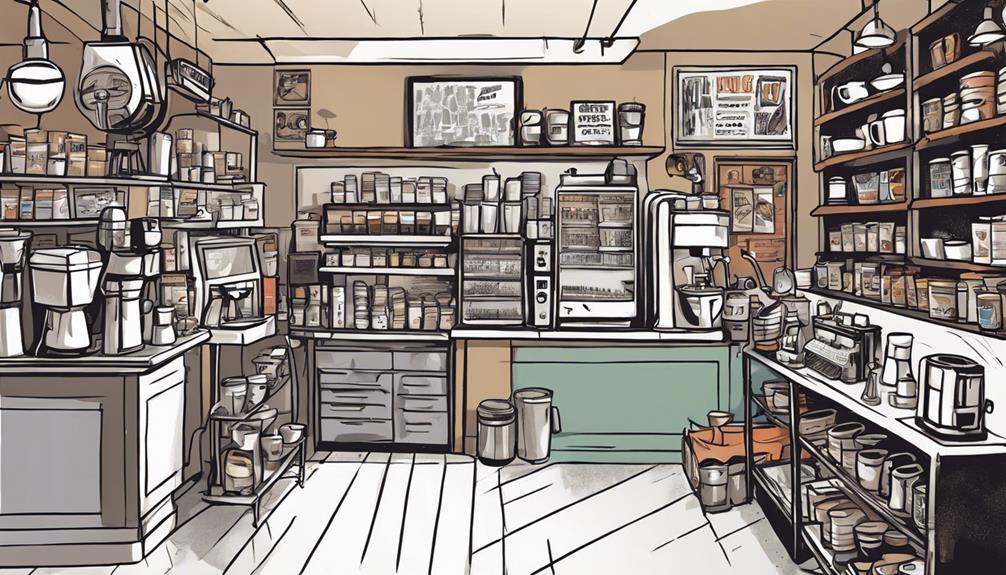
When setting up your coffee business, prioritize designing a welcoming and efficient layout for your shop. Consider factors like customer flow and seating arrangements to create a space that encourages customers to stay and enjoy their coffee. Additionally, choosing the right technology and POS systems can greatly enhance operational efficiency and streamline transactions, leading to better customer service. Be sure to comply with local laws, zoning permits, and regulations to avoid any operational setbacks or legal issues.
To help you visualize the essentials of operational setup, here is a table outlining key components:
| Operational Setup Essentials | Description |
|---|---|
| Coffee Shop Layout | Design a layout that optimizes customer flow and provides comfortable seating arrangements. |
| Technology and POS Systems | Choose efficient technology and POS systems to streamline transactions and enhance operational efficiency. |
| Compliance with Local Laws | Ensure adherence to local laws, zoning permits, and regulations for a smooth operational setup. |
Marketing and Management Tactics
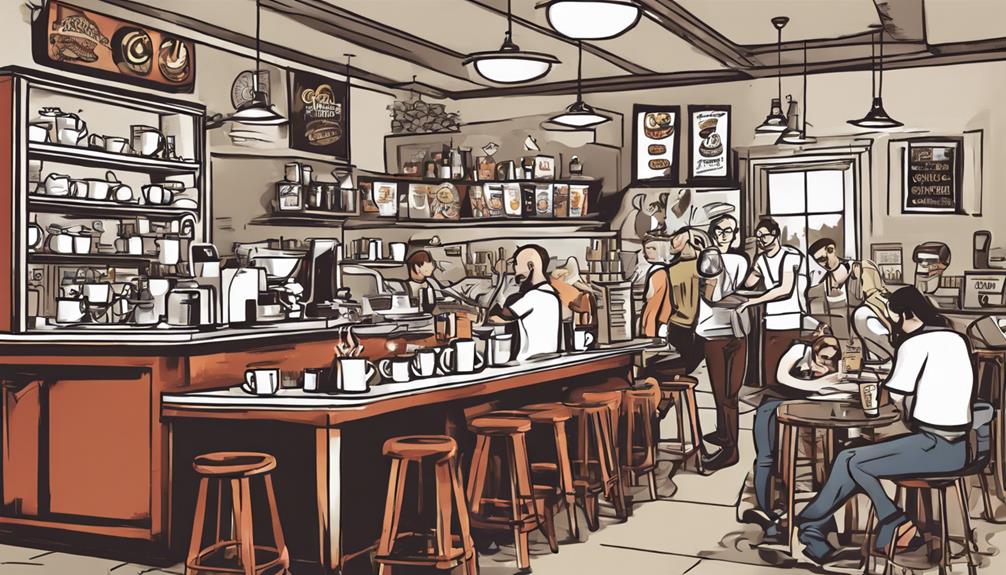
To excel in your coffee business, focus on implementing effective marketing strategies, developing a strong brand identity, and providing thorough staff training. These tactics will help you increase brand visibility, differentiate your business in a competitive market, and create a positive customer experience.
Marketing Strategies
Enhance your coffee business's visibility and customer engagement through strategic marketing tactics and management strategies. To effectively market your coffee business, consider the following key strategies:
- Utilize local collaborations: Partnering with local businesses, such as bakeries or bookstores, can help you reach a wider audience and attract new customers who frequent these establishments. By cross-promoting each other's products or services, you can create a mutually beneficial relationship that boosts both businesses.
- Develop a strong brand identity: Establishing a unique brand identity and culture for your coffee shop can set you apart from competitors and resonate with your target market. Guarantee that your brand messaging, visuals, and customer experience all align with your brand identity to create a cohesive and memorable impression on customers.
- Implement word-of-mouth marketing strategies: Encourage satisfied customers to spread the word about your coffee shop by providing exceptional service, quality products, and memorable experiences. Word-of-mouth marketing can be a powerful tool for driving customer acquisition and building a loyal customer base.
Brand Development
Focus on developing a strong brand identity by emphasizing authenticity, quality products, and competitive pricing strategies. Building a unique brand is vital for your coffee business.
Utilize marketing strategies such as offering free samples, collaborating with local businesses, and engaging in email marketing campaigns to establish your brand in the market.
Enhance customer engagement by focusing on word-of-mouth marketing and creating a distinct brand culture that resonates with your target audience. Remember, fostering employee satisfaction is also pivotal in delivering a consistent customer experience that aligns with your brand values.
To stand out in the competitive coffee market, stay updated on industry trends, network with peers, and prioritize customer experience. Implement a thorough brand strategy that includes maintaining a strong social media presence, running promotions, and ensuring consistent branding across all touchpoints.
Staff Training
Implement ongoing training programs for your staff on marketing and management tactics to guarantee a consistent and high-quality customer experience. Training your staff effectively on customer service skills and coffee preparation techniques is essential for the success of your coffee business.
Here are three key strategies to enhance staff training:
- Continuous Education: Provide regular training sessions to keep your staff updated on industry trends, new products, and customer preferences. This will ensure that they can deliver excellent service and stay competitive in the market.
- Positive Work Culture: Foster a positive work environment through team-building activities, incentives, and recognition for exceptional performance. Happy and motivated employees are more likely to provide outstanding customer service and represent your brand positively.
- Empowerment: Empower your staff to handle customer inquiries, resolve issues effectively, and upsell products to boost revenue. By giving them the tools and confidence to excel in their roles, you can create a team of skilled professionals dedicated to providing exceptional service.
Passion and Conceptualization
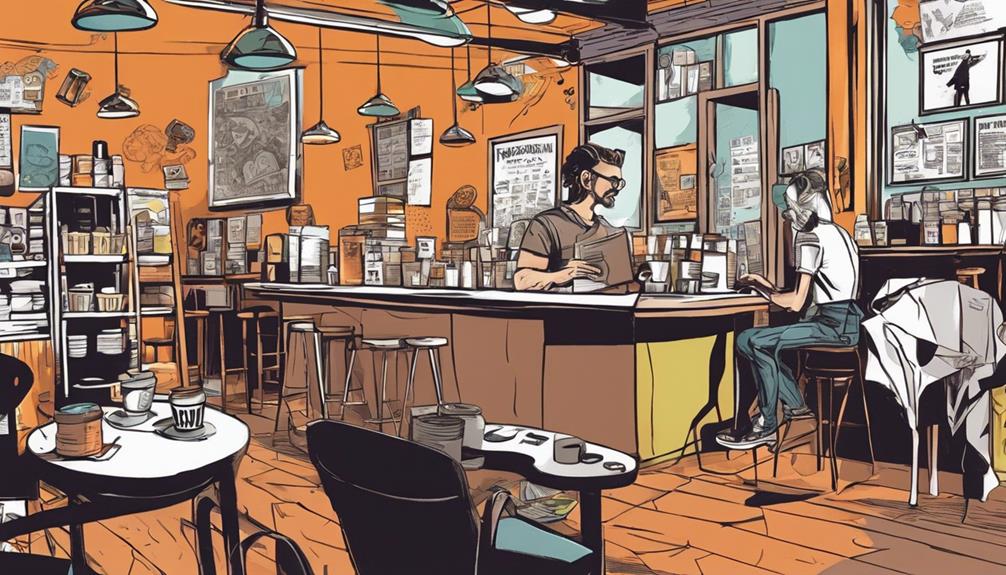
Your passion and vision are the driving forces behind the conceptualization of your coffee business. To create a successful venture, it's essential to infuse your unique concept with standout menu items that resonate with customers, setting your business apart from the competition.
By focusing on delivering exceptional product quality rather than just branding, you can create a memorable experience that keeps customers coming back for more.
Developing bold and distinctive offerings will help attract a niche customer base and establish a loyal following. Your genuine love for the coffee industry will be a significant asset in steering through the challenges of the competitive food business market and achieving success.
Legal Compliance and Real Estate
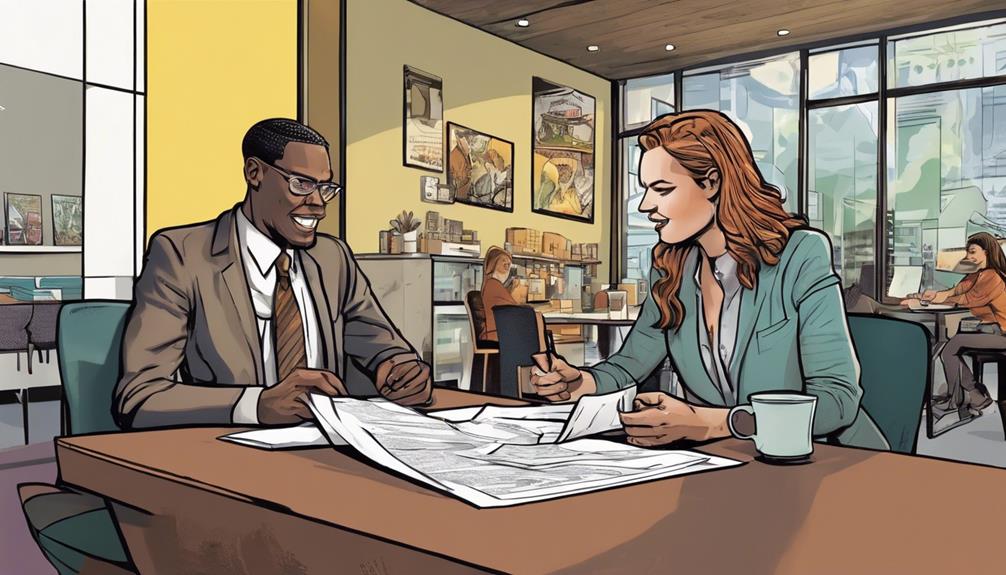
You need to obtain essential permits like EIN, business license, DBA license, and food service license to guarantee legal compliance.
Make sure to consult with a lawyer to cover all legal aspects, including entity formation, before launching your coffee business.
Additionally, hiring a real estate agent can help you select a strategic location considering factors such as visibility, accessibility, and target demographics.
Legal Permits Checklist
Legal compliance and real estate considerations play an important role in setting up a coffee business successfully. To secure your coffee shop operates lawfully and smoothly, follow this legal permits checklist:
- Business License: Obtain a business license along with an Employer Identification Number (EIN), Doing Business As (DBA) license, food service license, and appropriate insurance coverage to meet legal requirements.
- Permits: File for all necessary permits required for your coffee shop business to operate legally. This includes permits for health and safety, signage, and any other specific regulations in your area.
- Consultation: It's advisable to consult with a lawyer specializing in business law to review and confirm that all your legal documentation is in order before launching your coffee business. This step can help prevent legal issues down the line and secure compliance with all regulations.
Location Selection Tips
Selecting an appropriate location for your coffee business involves careful consideration of legal compliance and real estate factors. Before settling on a location, make sure you have the necessary permits and licenses for operation. It's vital to align your chosen real estate with zoning regulations and local laws to prevent potential legal issues down the line.
When scouting for a location, pay attention to key factors like foot traffic, demographics, and visibility to enhance your coffee shop's chances of success.
To navigate the complexities of real estate, collaborate with a seasoned commercial real estate agent who understands the unique requirements of your coffee business. They can assist you in finding a space that meets your needs and complies with all legal regulations.
When finalizing the location for your coffee shop, prioritize elements such as accessibility, parking options, and proximity to your target market to create a convenient and appealing setting for your customers. By carefully evaluating these aspects, you can set your coffee business up for a strong start in the right location.
Regulatory Compliance Essentials
Secure your coffee business complies with essential legal regulations and real estate requirements to establish a solid foundation for success.
When diving into the world of coffee entrepreneurship, make sure you have the necessary permits and licenses in place. This includes obtaining an Employer Identification Number (EIN), business license, Doing Business As (DBA) license, and food service license to operate legally.
Next, be mindful of local zoning laws and regulations when selecting a commercial space for your coffee shop. Ensure the location is compliant with the designated land use regulations to avoid potential conflicts.
Finally, consider the legal aspects of your business, such as insurance coverage. Protect your business and employees by having adequate insurance that covers various scenarios that may arise.
Execution and Customer Experience
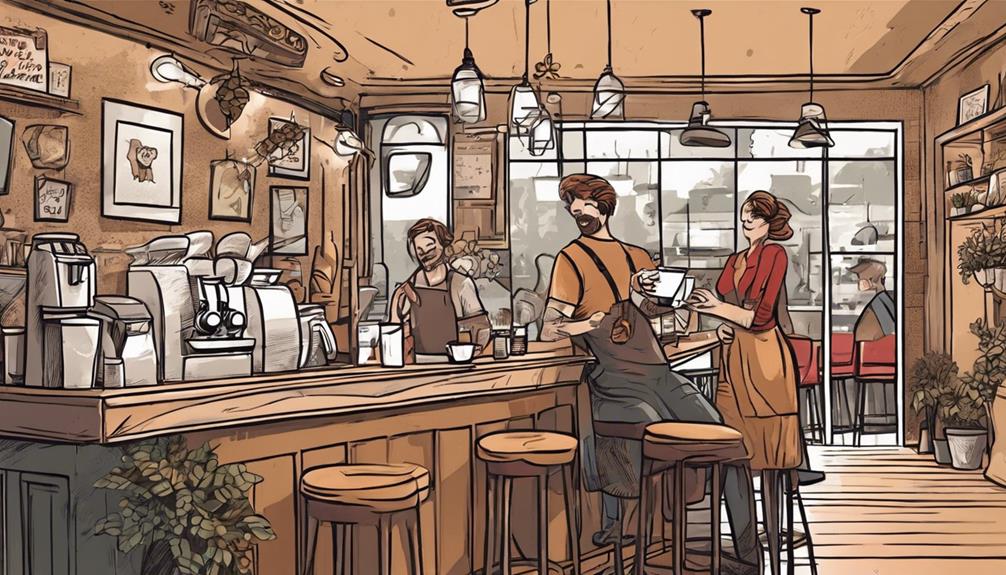
To secure the success of your coffee business, focus on creating a welcoming atmosphere and efficient workflow that enhance the customer experience.
Tailor your coffee shop environment to cater to your target customers' preferences, ensuring they've a memorable visit.
Prioritize customer satisfaction and operational efficiency during the execution phase to set the foundation for long-term success.
Be actively involved during the opening phase to guarantee that operations meet your standards for quality and service.
Emphasize consistency in branding and service excellence to differentiate yourself in the competitive coffee industry.
By maintaining a strong focus on customer experience, operational efficiency, and branding consistency, you can cultivate a loyal customer base and establish a reputable presence in the market.
Remember that every interaction with a customer is an opportunity to create a positive and lasting impression, driving the success of your coffee business.
Frequently Asked Questions
How Do I Become a Coffee Entrepreneur?
To become a coffee entrepreneur, start with a clear vision, research the market, and develop a solid business plan. Obtain necessary permits and licenses, invest in quality equipment, hire skilled staff, and focus on exceptional service to succeed.
How Can a Coffee Shop Business Be Successful Entrepreneur?
To make your coffee business successful, blend passion with strategy like a skilled barista crafting a perfect latte. Focus on your concept, target audience, marketing, staff training, customer service, cost management, innovation, and quality products to stand out and thrive.
How Profitable Is Owning a Coffee Shop?
Owning a coffee shop can be profitable, with margins ranging from 15% to 30%. Specialty coffee shops can yield higher profits due to premium pricing. Successful owners can earn $60,000 to $160,000 annually.
How to Start a Cafe Business From Scratch?
Starting a cafe business from scratch? First, craft a unique concept, nail down a killer menu, secure funding, and choose a prime location. Remember, success hinges on exceptional customer experience, efficient operations, and continuous improvement.
Conclusion
To sum up, building a successful coffee business requires passion, strategic planning, and relentless execution.
While the market may seem saturated, there's always room for innovation and creativity.
Don't let the fear of competition deter you from pursuing your dream.
Remember, with a strong business plan, solid financial backing, and a unique branding strategy, you can carve out your own niche in the industry and create a memorable customer experience that sets you apart.
Don't just dream it, brew it!




